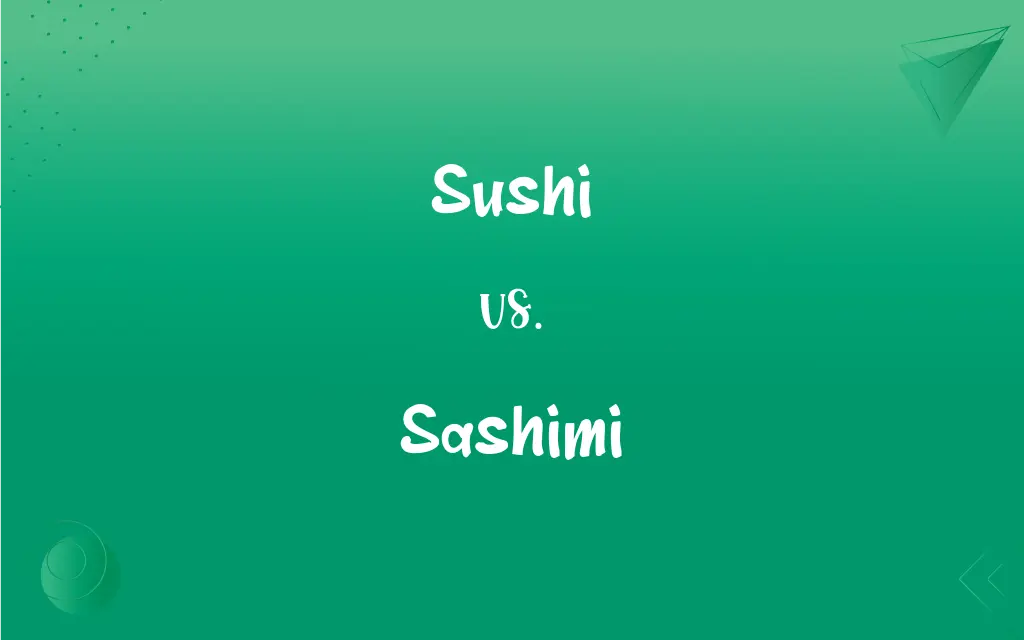Sushi vs. Sashimi: What's the Difference?
Edited by Janet White || By Harlon Moss || Updated on October 25, 2023
Sushi refers to vinegared rice often paired with other ingredients, including fish; sashimi is thinly sliced raw fish or meat.

Key Differences
Sushi and sashimi are both renowned Japanese dishes, but they cater to different culinary experiences. Sushi fundamentally involves vinegared rice, which can be topped or filled with a variety of ingredients, including fish. Conversely, sashimi spotlights raw fish or meat, served without rice.
When people think of sushi, they might envision maki rolls wrapped in seaweed or nigiri with a topping resting on rice. However, the essence of sushi is the seasoned rice, not the fish. On the other hand, sashimi stands alone, celebrating the pure, fresh taste of its primary ingredient, requiring no rice accompaniment.
The artistry in sushi revolves around combinations and presentation, blending flavors and textures. Sashimi, though, focuses on the meticulous slicing and presentation of the fish or meat, allowing the natural flavors to shine.
Another distinction lies in the accompaniments. Sushi might be paired with pickled ginger, wasabi, and soy sauce. While sashimi also complements wasabi and soy sauce, its slices might rest on daikon radish or shiso leaves.
It's paramount to note that while sushi can have raw fish, it can also feature cooked, pickled, or other non-fish ingredients. In contrast, sashimi remains dedicated to showcasing raw slices, emphasizing freshness and quality.
ADVERTISEMENT
Comparison Chart
Definition
Vinegared rice combined with various ingredients.
Thinly sliced raw fish or meat.
Main Ingredient
Seasoned rice.
Raw fish or meat.
Presentation
Can be rolls, hand-pressed, etc. with diverse ingredients.
Slices served without rice.
Accompaniments
Often served with pickled ginger, wasabi, and soy sauce.
Usually with wasabi and soy sauce, possibly over daikon or shiso.
Variability
Can include raw, cooked, or pickled ingredients.
Always raw.
ADVERTISEMENT
Sushi and Sashimi Definitions
Sushi
A Japanese dish of vinegared rice with various ingredients.
I ordered a sushi platter for dinner.
Sashimi
A Japanese delicacy that highlights the ingredient's freshness.
The chef recommended the freshest sashimi of the day.
Sushi
Not always raw; can have cooked or pickled components.
The eel sushi is grilled and served with a sweet sauce.
Sashimi
Thin slices of raw fish or meat, often served with daikon.
The salmon sashimi melted in my mouth.
Sushi
Can be wrapped in seaweed, like maki, or pressed, like nigiri.
She prefers nigiri sushi over rolls.
Sashimi
Is about purity, celebrating the unadulterated flavor.
The sashimi plate showcased a range of flavors from the sea.
Sushi
Represents a blend of flavors and textures.
The spicy tuna sushi had a delightful kick.
Sashimi
Requires precise slicing for optimal texture and taste.
The sashimi was expertly cut and beautifully presented.
Sushi
Seasoned rice often paired with seafood, vegetables, or egg.
The sushi rice was perfectly tangy and sticky.
Sashimi
Doesn't include rice or other core ingredients.
He appreciated the simplicity of sashimi over sushi.
Sushi
Cold cooked rice dressed with vinegar that is shaped into pieces and topped with raw or cooked fish, or formed into a roll with fish, egg, or vegetables and often wrapped in seaweed.
Sashimi
A Japanese dish consisting of very thin bite-size slices of fresh raw fish, traditionally served with soy sauce and wasabi.
Sushi
A Japanese dish made of small portions of sticky white rice flavored with vinegar, usually wrapped in seaweed and filled or topped with fish, vegetables or meat.
For the vegetarians, she served cucumber sushi.
Sashimi
A dish consisting of thin slices or pieces of raw fish or meat.
Sushi
(proscribed) Raw fish, especially as a Japanese dish.
Sashimi
Very thinly sliced raw fish
Sushi
Rice (with raw fish) wrapped in seaweed
FAQs
Is sashimi safer to eat than sushi?
Both require fresh, quality ingredients; sashimi emphasizes rawness.
What's the primary difference between sushi and sashimi?
Sushi involves vinegared rice; sashimi is raw fish/meat slices.
Is all sushi raw?
No, sushi can have cooked, pickled, or other ingredients.
Can sushi be vegetarian?
Yes, sushi can have vegetable, egg, or other fillings.
Do I need special knives for sashimi?
Ideally, yes. Precise slicing enhances texture and taste.
Why is the rice in sushi vinegared?
The tanginess balances flavors and aids preservation.
Can sushi have toppings?
Yes, like in nigiri sushi, where toppings rest on rice.
Why is sashimi served with daikon or shiso?
They complement and cleanse the palate.
Are there regional sushi variations?
Yes, ingredients and styles can vary regionally.
How do I store leftover sashimi?
Refrigerate promptly, but consume soon for best quality.
Does sashimi always need soy sauce?
It's a preference; some purists enjoy sashimi unseasoned.
Is sushi rice the same as regular rice?
No, sushi rice is seasoned with vinegar, sugar, and salt.
Are there fusion sushi styles?
Yes, like the Americanized California roll or spicy tuna roll.
Is sushi eaten with hands or chopsticks?
Both are acceptable; some types, like temaki, are hand-held.
What's inside a sushi roll?
It varies - fish, vegetables, egg, etc., wrapped in rice and seaweed.
Can sushi be dessert?
There are dessert sushi variations with sweet ingredients.
Can sashimi be spicy?
It's typically not, but spicy accompaniments can be added.
Why is sashimi sliced thin?
It enhances texture, flavor absorption, and presentation.
Is sashimi always about fish?
Mostly, but it can also feature thinly sliced raw meat.
How do I ensure sashimi's safety?
Use fresh, quality ingredients and proper preparation methods.
About Author
Written by
Harlon MossHarlon is a seasoned quality moderator and accomplished content writer for Difference Wiki. An alumnus of the prestigious University of California, he earned his degree in Computer Science. Leveraging his academic background, Harlon brings a meticulous and informed perspective to his work, ensuring content accuracy and excellence.
Edited by
Janet WhiteJanet White has been an esteemed writer and blogger for Difference Wiki. Holding a Master's degree in Science and Medical Journalism from the prestigious Boston University, she has consistently demonstrated her expertise and passion for her field. When she's not immersed in her work, Janet relishes her time exercising, delving into a good book, and cherishing moments with friends and family.































































